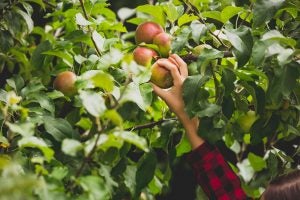Farmers use many marketing strategies to diversify their incomes and stay in business. New research suggests that two of these strategies — agritourism and direct farm sales — complement one another when they occur within the same community. The findings could help farmers and the local organizations that support them plan strategically for farm resilience and growth.
“Agritourism and direct sales are important and growing supplemental sources of revenue for farmers, allowing some to stay in business when they otherwise would not be able to,” said Claudia Schmidt, assistant professor of marketing and local/regional food systems in Penn State’s College of Agricultural Sciences, who led the research. “Our study found that more agritourism operations are associated with more direct sales in the same county, and vice versa. That is, when these activities take place near one another, they are complementary, not competitive.”
Using several data sources, including the U.S. Census of Agriculture, the researchers conducted an analysis at the U.S. county level to determine whether these activities detract from or reinforce one another, both within counties and across county lines. Specifically, they examined farm income generated from agritourism and direct sales, the extent to which they are correlated, and how these activities are geographically clustered.

Researchers also analyzed several other variables known to influence farm income, including farm characteristics, farm-owner or operator characteristics, the type of farming practiced, and the socioeconomic conditions in the farm’s home county.
Agritourism, according to the U.S. Census of Agriculture, is defined as “agri-tourism and recreational services such as farm or winery tours, hay rides, hunting, fishing, etc.” Direct sales are those made directly from farmer to consumer, for example at a farm stand, farmers markets, “pick-your-own” operations, and through subscription-based arrangements. Consumer interest in both activities has been on the rise, especially since the onset of the COVID-19 pandemic, according to Schmidt.
The study, which was published this week in Agricultural and Resource Economics Review, helps to characterize the types of farms that engage in these activities. For example, the researchers found hotspots — clusters of farms engaging in agritourism and direct sales within the same county and neighboring counties — in the Northeast, coastal areas in the West, and counties around the Great Lakes. The analysis also shows that female-operated farms are statistically more likely to engage in agritourism than in direct sales efforts.
The researchers cautioned about the study’s limitations, pointing to a need for more complete and thorough data related to agritourism and direct sales, given their growing importance to farm viability, rural community vitality, and agricultural literacy.
“The USDA Census of Agriculture is the best source of data we currently have for comparisons over time. However, because agritourism is narrowly defined by the Census of Ag, it leads to underestimates and does not allow us to distinguish between the many different types of agritourism experiences offered,” said Lisa Chase, University of Vermont Extension Professor and Director of the Vermont Tourism Research Center. “Similarly, the direct sales question only includes food products, excluding crops like Christmas trees and cut flowers, and it does not allow us to distinguish between on-farm and off-farm sales. These limitations inhibit our understanding of agritourism and direct sales, and our ability to support farmers and their communities throughout the country.”


